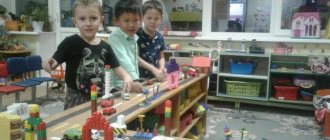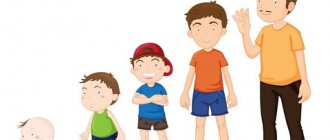Methodological development “Musical and rhythmic movements in kindergarten”
Irina Chichina
Methodological development “Musical and rhythmic movements in kindergarten”
Musical and rhythmic movements in kindergarten
“Perhaps the best, most perfect and joyful,
What life has is free movement to music .
And you can learn this from a child and with him.”
Anna Iosifovna Burenina
Music is the most emotional art (D. B. Kabalevsky)
.
Its impact on the formation of personality is enormous. “ It’s hard to imagine a person’s life music Without the sounds of music, it would be incomplete, deaf, poor... Music lovers and connoisseurs are not born , but become.” These words of the greatest composer of our time, D. Shostakovich, most fully reflect the basic view of the musical ear for music at all .” A fairly common formula for determining the reason for the lack of abilities of a son or daughter. However, everything in reality is somewhat different. Teachers and musicians have come to the conclusion that everyone has the inclinations for musical activity , i.e., the physiological abilities of the body, for example, the organ of hearing or the vocal apparatus. It is this that forms the basis for the development of musical abilities . And therefore it is considered proven that if the necessary conditions are created for musical development, then this has a significant effect in the formation of his musicality .
What is musicality ? This is a set of abilities that allow a person to actively express himself in various types of musical activities : listening, singing, movement .
Musical-rhythmic movements are a synthetic type of activity - this is one of the types in which the content of music , its character, and images are conveyed in movements . Therefore, any movements to music develop an ear for music , motor abilities, and the mental processes that underlie them and contribute to the emotional and psychophysical development of children.
Movements to music have been used in raising children since ancient times (Ancient India, China, Greece)
.
the Swiss teacher and composer Emile Jacques Dalcroze who first considered rhythm and substantiated it as a method of musical Before rhythmics, he first of all set the task of developing musical abilities , as well as plasticity and expressiveness of movements . The special value and viability of his system of musical and rhythmic education lies in its humane nature. E. Jacques-Dalcroze was convinced that it was necessary to teach rhythm to all children. He developed in them a deep “feeling”
, penetration into
music , creative imagination, formed the ability to express themselves in movements , and at the same time believed that music is the fundamental principle. The synthesis of music and movements concretizes the game image. On the one hand, the musical image contributes to a more accurate and emotional execution of movements , on the other hand, the movements explain music , the main means of expression. Such complex phenomena as meter rhythm, register, musical form , which are difficult to explain to children in words, are perceived by preschoolers not only with the ear, but with the whole body, this increases the musical experience , making it more conscious.
Movement exercises are of invaluable importance, especially for somatically weakened children, children with an unstable nervous system, immaturity of the emotional-volitional sphere. After all, motor exercises primarily train the brain and the mobility of nervous processes . Therefore, it is so important to introduce clumsy, motor-inhibited children to movement to music , who need to be helped to gain feelings of self-confidence or, conversely, disinhibited and hyperactive children, in order to teach them to control their emotions and feelings. In the process of mastering movements to music children learn to focus on music as a special signal for action and movement , they improve motor skills, coordination of movements , develop voluntary movements , non-verbal communication abilities, and form and develop ideas about the connection between music and movements .
Scientific research has proven that any sound causes muscle contractions in humans. The whole body responds to the action of music . The perception and understanding of music lies in the sensation of it through the ligaments, muscles, movement , and breathing. Musicologist professor L. Medushevsky wrote: “The infinitely rich information contained in music is read not by the mind, but by the dynamic state of the body - co-intonation, pantomimic movement .” It is known that movement influences the nature of perception of music .
B. M. Teplov also proved the fact that the perception of music by motor reactions (vocalizations, small finger movements, etc. )
.
Also, well-known domestic and foreign teachers and psychologists studied the problem of musical-rhythmic education. Among them: D. B. Kabalevsky, B. M. Teplov, E. A. Flerina, M. A. Rumer, T. S. Babajan, N. A. Metlov, Yu. A. Dvoskina, A. V. Keneman, S. D. Rudneva, N. A. Vetlugina, O. P. Radynova, A. I. Burenina and many others.
Introducing children to music comes in different ways. In the field of musical and rhythmic activity, it occurs through accessible and interesting proposals - exercises, musical games , dances, round dances, which help the child to better feel and love music , get into its mood, realize the nature of the work, understand the form, expressive means.
Musical and rhythmic activities are aimed at developing aesthetic, physical, moral and mental qualities in each child.
In the field of musical-rhythmic movements, the following tasks are solved:
1. Enrich children's musical experiences and create a joyful mood.
2. Develop rhythmic movements to music .
3. Lead to expressive execution of movements , to joint and individual actions.
, musical and rhythmic skills are developed :
• Start movements independently after entry ;
• Independently change movements depending on the form (2 and 3-part, dynamics (loud - quiet, register (high - low)
;
• Perform movements , in general, for all tempos, coordinate them;
• Move at a moderate, fast pace.
When learning musical and rhythmic tasks, the teacher uses various methodological techniques , taking into account the age characteristics of the children.
One of the most important teaching techniques is a holistic visual and auditory demonstration. Music and movements are one . Teacher alone (or with a child)
can show
a movement being learned to musical accompaniment . Correct demonstration of movements and precise instructions help the child perform a particular movement .
Thus, the perception of music is an active auditory-motor process. Through movement music more vividly and emotionally , feels the change in its mood, consolidates knowledge about the means of musical expression , understands and feels it, develops emotions, interests, tastes, i.e., becomes familiar with musical culture , and his spiritual world is enriched.
It's no secret that people love to move to music , but spontaneous dance is not a product of human intellectual activity, it is rather a movement that occurs at the subconscious level. It is much more difficult to accurately perform a set of movements in a certain sequence to certain music . It is even more difficult to dance in a group when it is necessary not only to perform a movement , but also to perform them synchronously. When learning a dance, many of the child’s skills are trained: memorization of individual movements and movements in a complex , coordination of movements , the ability to listen to music movements to it (i.e., a sense of rhythm, the ability to express themselves creatively. All these skills help to form the child’s mental abilities, i.e. e. help develop intelligence.
Music , movement and the development of intelligence are closely related. The emotional impact of music is deeply comprehended by the child and acquires a personal impact. Raising a smart child is difficult, but raising a sensitive person is even more difficult.
Musical-rhythmic movement , or in other words, dance, is a form of learning that is comfortable, interesting, and gives the opportunity for self-expression.
Developing a child harmoniously, solving these and other tasks, it is necessary to understand exactly what we want from this particular child now and in the expected future. It is at preschool age that children do not experience the feeling of inconvenience or embarrassment associated with the fact that something may not work out. Freedom of movement is lightness and joy. I really like the motto of G. P. Fedorova: “Dancing is developing the mind”
. It is in preschool age that the foundations of harmonious mental, moral, and physical development are laid, and the child’s personality is formed.
Mastering dance compositions, children memorize certain combinations of alternating movements , while striving to interact with each other, navigate in space, and improvise.
Children have their own perception of what happens in class - they are all unpredictable, and, oddly enough, children are interested in more complex compositions, and they perform them with greater emotional impact.
Emotionality is achieved not only by musical accompaniment , but also by figurative exercises and complex compositions that meet the age characteristics of preschoolers who are prone to imitation and copying adults.
Experts call children of preschool age labor geniuses and great creators. The child creates not only drawings or plasticine figures, not only dance compositions and simple songs - the child creates himself, improves memory and attention, character and will.
The value of children's creativity is not in the result, but in the process; it is needed not by the audience, but by the children.
Much is changing in our lives, but I want to believe that one of the principles of humanistic pedagogy: “Where there is benefit for children, there should also be pleasure for them M. Montel” will help solve the tasks assigned to us, teachers and parents, to help preschool children age in the aesthetic game to enter the world of music , feel and experience it sensually, create the prerequisites for the formation of creative thinking, and promote the practical assimilation of musical knowledge .
A child should not be afraid to make mistakes. That's why he's a child, so he can't do much. That's why we are adults, to teach. We need to look for ways to each other, ways of understanding, then the process of learning and education will bring joy to both adults and children.
Ps: In kindergarten, instead of the term “rhythmic movements ,” “ musical-motor education ,” then “ movement to music ,” “ musical movement ,” “ musical-rhythmic movements ,” “ musical-rhythmic activity .” There has been debate over the years about the most precise formulation. However, there is no fundamental difference between all these terms, since most specialists in musical and rhythmic education in preschool institutions rightly considered music the “starting point” in rhythm, and movement as a means of its assimilation.
“Musical-rhythmic movements as a type of musical activity for preschool children”
This system of work contributes to achieving the following results:
children easily and freely use a variety of movements in improvisation, subtly conveying a musical image;
the process of learning a new repertoire takes a little time - 2-3 lessons;
children have a certain repertoire that is ready to be shown at a performance.
Another advantage of using such a system of work is that the teacher feels some relief in his professional activities, since he spends much less effort on learning the repertoire.
“Pedagogy must be economical” is the motto of the proposed approach. Therefore, it is important to review the content of the work, remove all that is sticky and unite the efforts of all specialists, and provide children with more time for independent play, creative activities and walks.
However, this result is not achieved immediately, as it requires a certain amount of time, gradually increasing the complexity of tasks and varying the forms and methods of working with children.
Let us consider in more detail this system of work, in which we roughly distinguish three stages.
At the 1st stage
(the beginning of using musical and rhythmic compositions in working with children) we rely on children’s ability
to imitate,
which is clearly expressed in preschool age. By imitating an adult, the child masters various types of movements and gradually begins to use them in independent activities (in games, dance improvisations).
2nd stage
training (after the children have already acquired some experience in performance by demonstration and have memorized several compositions) contributes to the development in children of the ability to
independently
perform previously learned exercises, compositions in general and individual movements.
3rd stage
work - leading children to
a creative interpretation
of a piece of music, developing the ability to
express themselves
in movement to music, developing the ability to independently select and combine familiar movements and come up with their own, original exercises. The implementation of these tasks is most important in this program, since it is in the development of creativity and the ability to improvise that the main idea is concentrated - control of one’s own body, subtlety of musical perception, non-standard thinking, psychological freedom. We approach each stage sequentially, but, at the same time, they can be combined (but with different repertoires).
So, to summarize what has been said, we emphasize that improvisation, both in children and adults, is possible only on the basis of the development of an ear for music, creative imagination, as well as on the basis of free control of one’s body, that is, when movements are automated and do not distract attention from the technique of their execution. Jacques Dalcroze also believed: “When everything related to rhythm and technique passes into the category of automatic, all attention will be freed up to convey the feeling invested in rhythm and sounds.”
Therefore, if we want to achieve a truly artistic, and not a primitive interpretation of musical works in plastic, a lot of and meticulous work on motor skills is necessary.
But the process of this technical work must also be engaging, playful and creative.
And then children will develop, learn movements easily and involuntarily, unnoticed by themselves, mastering various and complex motor combinations. And this in turn will stimulate their overall development.






